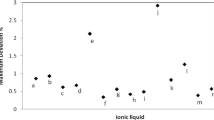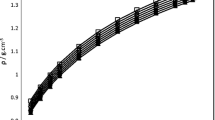Abstract
The recent discovery of liquid-liquid phase separations in electrolyte solutions with critical points near room temperature enables the systematic study of the critical behavior of ionic fluids. Depending on the nature of the molecular interactions, either sharp mean-field or Ising behavior is obtained in the temperature range down tot=(T−T c )/T c =10−4 or less. Mean-field-like criticality is obtained with systems which in the framework of a simple corresponding states model are fairly close to the critical point of the “restricted primitive model” (RPM) of equally-sized charged spheres in a dielectric continuum. In these cases the phase separation is driven by the Coulombic forces (so-calledCoulombic phase separations). This type of unmixing occurs for 1∶1 electrolytes in solvents of low dielectric constant. Simple mechanisms for unmixing suggested in the literature are discussed in relation to the available data. Some evidence for departures from the simple RPM prediction is found. The presence of additional short-range interactions leads to sharp Ising behavior. Examples are solutions of tetraalkylammonium salts in water and other highly structured solvents, where phase separation results from the peculiar solvophobic nature of ions (solvophobic phase separations). Previous speculations that this type of unmixing shows the tendency toward closed loops are confirmed by the first direct observation of a lower consolute point in an aqueous solution of propyl-tributylammonium iodide. By light scattering studies and measurements of the coexistence curve near the upper and lower consolute points Ising criticality is confirmed. A new mechanism for phase separation is reported for the system ethylammonium nitrate+octanol, where ion pairs are stabilized by hydrogen bonding beyond what is expected from the RPM. This comparatively subtle additional interaction (so-calledstricky ions) already changes the behavior of otherwise RPM-like systems from mean-field to Ising criticality. The results are discussed with particular emphasis on their implications for possible scenarios for explaining a mean-field critical point or crossover from mean-field to Ising behavior beyond the accessible temperature range.
Similar content being viewed by others
References
L. Onsager,Phys. Rev. 65:117 (1944).
R. R. Singh and K. S. Pitzer,J. Chem. Phys. 92:6775 (1990).
H. Weingärtner, S. Wiegand, and W. Schröer,J. Chem. Phys. 96:848 (1992).
K. C. Zhang, M. E. Briggs, R. W. Gammon, and J. M. H. Levelt Sengers,J. Chem. Phys. 97:8692 (1992).
M. Buback and E. U. Franck,Ber. Bunsenges. Phys. Chem. 76:350 (1972).
I. G. Dillon, P. A. Nelson, and B. S. Swanson,J. Chem. Phys. 44:4229 (1966).
H. Weingärtner, T. Merkel, U. Maurer, J.-P. Conzen, H. Glasbrenner, and S. Käshammer,Ber. Bunsenges. Phys. Chem. 95:1579 (1991).
R. R. Singh and K. S. Pitzer,J. Am. Chem. Soc. 110:8723 (1988).
V. L. Ginzburg,Sov. Phys. Solid 2:1824 (1962).
D. J. Amit,J. Phys. C. 7:3369 (1974).
M. A. Anisimov, S. B. Kiselev, J. V. Sengers, and S. Tang,Physica A 188:487 (1992).
M. Kac, G. E. Uhlenbeck, and P. C. Hemmer,J. Math. Phys.,4:216 (1963).
R. F. Kayser and H. J. Raveche,Phys. Rev. A 29:1013 (1984).
G. Stell,Phys. Rev. B 1:2265 (1970).
M. E. Fisher, S.-K. Ma, and B. G. Nickel,Phys. Rev. Lett. 29:917 (1972).
P. Pfeuty and G. Toulouse,Introduction to Renormalization Group and to Critical Phenomena (Wiley, New York, 1977), p. 33.
J. G. Kirkwood,J. Chem. Phys. 2:351 (1934).
G. Stell, K. C. Wu, and B. Larsen,Phys. Rev. Lett. 37:1369 (1976).
K. S. Pitzer and D. R. Schreiber,Mol. Phys. 60:1067 (1987).
A. Z. Panagiotopoulos,Fluid Phase Equil. 76:97 (1992).
B. Hafsköld and G. Stell, InThe Liquid State of Matter, E. W. Montroll and J. L. Lebowitz, eds. (North-Holland, New York, 1982), p. 175.
G. Stell,Phys. Rev. A 45:7628 (1992).
G. Stell,J. Stat. Phys., this issue.
M. E. Fisher,J. Stat. Phys. 75:1 (1994).
A. L. Khodolenko and A. L. Beyerlein,J. Chem. Phys. 93:8403 (1990).
A. L. Khodolenko and A. L. Beyerlein,Phys. Lett 132:347 (1988).
R. Baxter,Exactly Solvable Models in Statistical Mechanics (Academic Press, New York, 1982).
M. E. Fisher,J. Chem. Phys. 96:3352 (1992).
M. L. Japas and J. M. H. Levelt Sengers,J. Phys. Chem. 94:5361 (1990).
H. Weingärtner,Ber. Bunsenges. Phys. Chem. 93:1058 (1989).
E. Steinle and H. Weingärtner,J. Phys. Chem. 96:2407 (1992).
H. Xu, H. L. Friedman, and F. O. Raineri,J. Solution Chem. 20:739 (1991).
J. L. Caillol,J. Chem. Phys. 100:2161 (1994).
L. Verlet,Phys. Rev. 159:98 (1967).
K. S. Pitzer,Acc. Chem. Res. 23:333 (1990).
V. M. McGahay and M. Tomozawa,J. Chem. Phys. 97:2609 (1990).
H. L. Friedman and B. Larsen,J. Chem. Phys. 70:92 (1979).
P. Walden and M. Centnerszwer,Z. Phys. Chem. 42:432 (1903).
M. J. Sienko, ed.,Metal-Ammonia Solutions (Benjamin, New York, 1964).
P. Chieux and M. J. Sienko,J. Chem. Phys. 53:566 (1970).
F. Leclerc, P. Damaya, and P. Chieux,Z. Phys. Chem. 156:183 (1988).
J. F. Jal, P. Chieux, P. Dupuy, and J. P. Dupin,J. Phys. (Paris)41:657 (1980).
V. M. Nabutovskii, N. A. Nemov, and Yu. G. Peisakhovich,Mol. Phys. 54:979 (1985).
J. S. Hoye and G. Stell,J. Phys. Chem. 94:7899 (1990).
D. W. Jepsen and H. L. Friedman,J. Chem. Phys. 38:846 (1963).
C. W. Outwhite,Mol. Phys. 33:1229 (1977).
C. F. J. Böttcher,Theory of Electric Polarization, Vol. 1 (Elsevier, Amsterdam, 1973), p. 77; see also W. Schröer,Adv. Chem. Phys. 48:183 (1981).
J. S. Hoye and G. Stell,J. Chem. Phys. 65:18 (1976);71:1985(1979).
G. Stell, G. N. Patey, and J. S. Hoye,Adv. Chem. Phys. 48:183 (1981).
V. Steinberg, A. Voronel, D. Linsky, and U. Schindewolf,Phys. Rev. Lett. 45: 1338 (1980).
M. E. Fisher and Y Levin,Phys. Rev. Lett, in press.
N. Bjerrum,Kgl. Danske Vidensk. Selsk. Mat.-Fys., Medd. 7:1 (1926).
R. M. Fuoss and C. A. Kraus,J. Am. Chem. Soc. 55:2387 (1933).
H. L. Friedman,J. Phys. Chem. 66:1595 (1962).
D. R. Schreiber, M. C. P. de Lima, and K. S. Pitzer,J. Phys. Chem 91:4087 (1987).
L. C. Kenausis, E. C. Evers, and C. A. Kraus,Proc. Natl. Acad. Sci. USA 48:121 (1962).
L. C. Kenausis, E. C. Evers, and C. A. Kraus,Proc. Natl. Acad. Sci. USA 49:141 (1963).
A. M. Sukhotin,Russ. J. Phys. Chem. 34:29 (1960), and references therein.
K. S. Pitzer and J. M. Simonson,J. Am. Chem. Soc. 106:1973 (1984).
W. E. Price and H. Weingärtner,J. Phys. Chem. 95:8933 (1991).
H. Weingärtner, W. E. Price, A. V. J. Edge, and R. Mills,J. Phys. Chem. 99: 6289 (1993).
H. L. Friedman, F. O. Raineri, and D. M. Wood,Chem. Scripta 29A:49 (1989).
E. C. Zhong and H. L. Friedman,J. Phys. Chem. 92:1685 (1988).
S. C. Greer and M. R. Moldover,Annu. Rev. Phys. Chem. 32:233 (1981).
J. V. Sengers and J. M. H. Levelt Sengers,Annu. Rev. Phys. Chem. 37:189 (1986).
R. R. Singh and K. S. Pitzer,J. Chem. Phys. 90:5742 (1989).
D. Kawasaki, InPhase Transitions and Critical Phenomena, Vol. 5A, QC. Domb and J. L. Lebowitz, eds. (Academic Press, New York, 1983).
D. Woermann and W. Sarholtz,Ber. Bunsenges. Phys. Chem. 69:319 (1965).
W. Schröer, M. Kleemeier, and H. Weingärtner, to be published.
W. Schröer, S. Wiegand, W. Staude, and Th. Peters,Ber. Bunsenges. Phys. Chem. 95:1126 (1991)
A. R. Kortan, H. V. Känel, R. J. Birgeneau, and J. D. Lister,Phys. Rev. Lett. 47:1206 (1981).
C. A. Kraus,J. Phys. Chem. 60:129 (1956), and references therein.
H. Weingärtner, T. Merkel, S. Käshammer, W. Schröer, and S. Wiegand,Ber. Bunsenges. Phys. Chem. 97:970 (1993).
S. H. Lee, J. C. Rasaiah, and P. T. Cummings,J. Chem. Phys. 83:317 (1985).
G. Stell and Y. Zhou,J. Chem. Phys. 91:3618, (1989).
W. Schröer, S. Wiegand, and H. Weingärtner,Ber. Bunsenges. Phys. Chem. 97:975 (1993).
J. M. H. Levelt Sengers and J. A. Given,Mol. Phys. 80:899 (1993).
G. Meier, D. Schwan, K. Mortensen, and S. Jansen,Europhys. Lett. 22:577 (1993).
J. Kendall, E. D. Grittenden, and K. H. Miller,J. Am. Chem. Soc. 45:963 (1923).
C. Sinistri, P. Franzosini, A. Timidei, and M. Rolla,Z. Naturforsch. A 20:561 (1965).
F. Hensel,J. Phys. (Cond. Matter) Spec. Issue “Liquids” 3A:SA33 (1991), and references therein.
Static Dielectric Constants of Pure Liquids and Liquid Mixtures, Landolt-Börnstein Series, Group IV, Vol. 6 (Springer, Berlin, 1991).
Author information
Authors and Affiliations
Rights and permissions
About this article
Cite this article
Weingärtner, H., Kleemeier, M., Wiegand, S. et al. Coulombic and non-Coulombic contributions to the criticality of ionic fluids. An experimental approach. J Stat Phys 78, 169–196 (1995). https://doi.org/10.1007/BF02183345
Received:
Issue Date:
DOI: https://doi.org/10.1007/BF02183345




